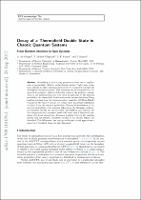Please use this identifier to cite or link to this item:
https://hdl.handle.net/20.500.12202/4298Full metadata record
| DC Field | Value | Language |
|---|---|---|
| dc.contributor.author | del Campo, A. | - |
| dc.contributor.author | Molina-Vilaplana, J. | - |
| dc.contributor.author | Santos, Lea F. | - |
| dc.contributor.author | Sonner, J. | - |
| dc.date.accessioned | 2018-12-31T21:46:03Z | - |
| dc.date.available | 2018-12-31T21:46:03Z | - |
| dc.date.issued | 2018-09 | - |
| dc.identifier.citation | del Campo, A., Molina-Vilap-0lana, J., Santos, L. and J. Sonner. (2018). Decay of a thermofield-double state in chaotic quantum systems. The European Physical Journal - Special Topics 227.3-4: 247-258. | en_US |
| dc.identifier.issn | 1951-6355 | - |
| dc.identifier.uri | https://doi.org/10.1140/epjst/e2018-00083-5 | en_US |
| dc.identifier.uri | https://hdl.handle.net/20.500.12202/4298 | - |
| dc.description.abstract | Scrambling in interacting quantum systems out of equilibrium is particularly effective in the chaotic regime. Under time evolution, initially localized information is said to be scrambled as it spreads throughout the entire system. This spreading can be analyzed with the spectral form factor, which is defined in terms of the analytic continuation of the partition function. The latter is equivalent to the survival probability of a thermofield double state under unitary dynamics. Using random matrices from the Gaussian unitary ensemble (GUE) as Hamiltonians for the time evolution, we obtain exact analytical expressions at finite Nfor the survival probability. Numerical simulations of the survival probability with matrices taken from the Gaussian orthogonal ensemble (GOE) are also provided. The GOE is more suitable for our comparison with numerical results obtained with a disordered spin chain with local interactions. Common features between the random matrix and the realistic disordered model in the chaotic regime are identified. The differences that emerge as the spin model approaches a many-body localized phase are also discussed. | en_US |
| dc.description.sponsorship | AdC acknowledges funding support from the John Templeton foundation and UMass Boston (project P20150000029279). LFS is supported by the NSF grant No. DMR-1603418 and thanks E.J. Torres-Herrera for several discussions about the correlation hole in spin models. JS is supported by the FNS grant No. 200021 162796 as well as the NCCR 51NF40-141869 The Mathematics of Physics (SwissMAP). JMV is supported by Ministerio de Econom ́ıa y Competitividad FIS2015-69512-R and Programa de Excelencia de la Fundaci ́on S ́eneca 19882/GERM/15. | en_US |
| dc.language.iso | en_US | en_US |
| dc.publisher | EDP Sciences | en_US |
| dc.relation.ispartofseries | The European Physical Journal - Special Topics;227(3-4) | - |
| dc.rights | Attribution-NonCommercial-NoDerivs 3.0 United States | * |
| dc.rights.uri | http://creativecommons.org/licenses/by-nc-nd/3.0/us/ | * |
| dc.subject | thermofield-double state | en_US |
| dc.subject | chaotic quantum systems | en_US |
| dc.title | Decay of a thermofield-double state in chaotic quantum systems. | en_US |
| dc.type | Article | en_US |
| dc.contributor.orcid | 0000-0001-9400-2709 | |
| local.yu.facultypage | https://www.yu.edu/faculty/pages/santos-lea | |
| Appears in Collections: | Stern College for Women -- Faculty Publications | |
Files in This Item:
| File | Description | Size | Format | |
|---|---|---|---|---|
| Samntos arXiv preprint Decay EPJ 1709.10105.pdf | arxiv preprint | 922.22 kB | Adobe PDF |  View/Open |
This item is licensed under a Creative Commons License

